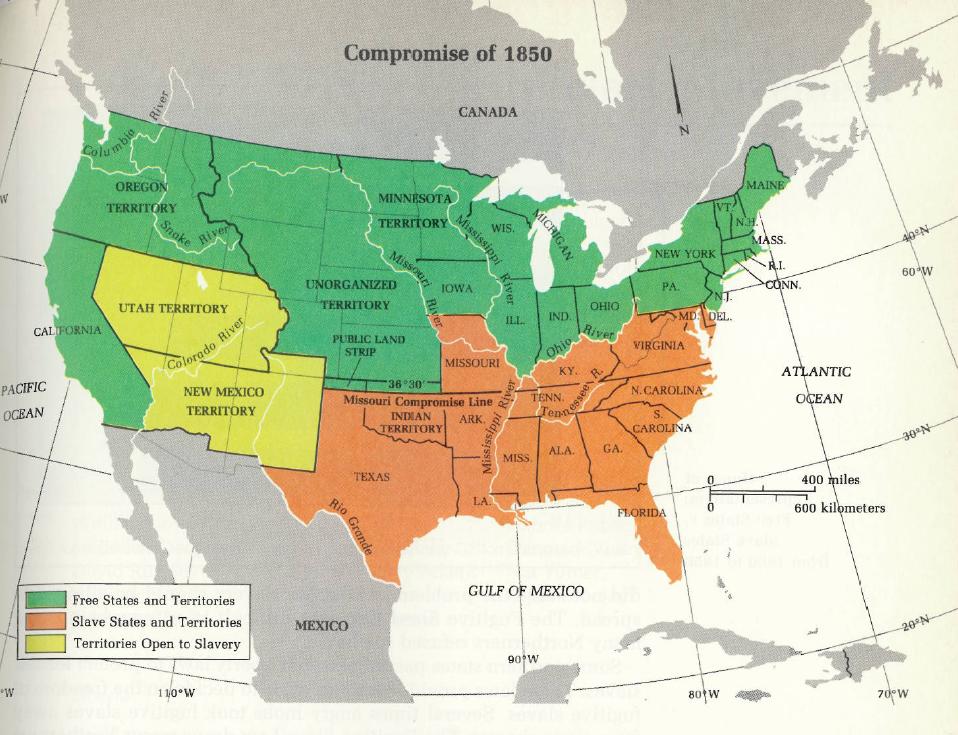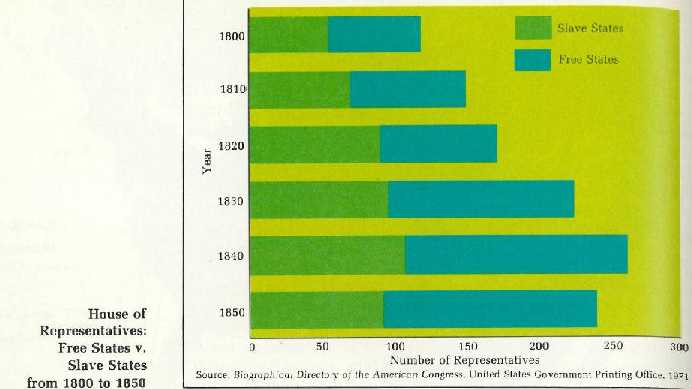|
Compromise again
Looking Ahead
After the end of this section, you will be able to:
- identify the problem the Wilmot Proviso was supposed to solve;
- state each presidential candidate's view on the spread of slavery into the new territories (after the Mexican War);
- summarize the Compromise of 1850 and its results;
- gather data by comparing maps.
Sectional interests had threatened the Union since the early days of the new nation. A serious threat to the future of the Union occurred when Missouri applied for statehood in 1818. A longer and bitter debate finally ended in the Missouri Compromise that kept the balance between free and slave states at 12 each. In 1832, South Carolina threatened to ignore a protective tariff and secede from the Union. The crisis passed when Congress approved Clay’s compromise tariff the following year. But as the US entered the 1850s, slavery was becoming the greatest danger to the security of the Union.
Wilmot Proviso
In 1846, when war broke out between the US and Mexico, sectional interests reappeared. Many Northerners opposed the war because they saw it as a southern plot to spread slavery to any new territory the US might gain. To prevent this, David Wilmot, a representative from Pennsylvania, introduced the Wilmot Proviso. It stated that slavery should be forbidden in any former Mexican territory. Speaking for the South, [F] [Es] [I] John C. Calhoun argued that the proviso was unconstitutional.
According to Calhoun, Congress had a duty to protect the rights of slave owners to take their property into new territory. The Wilmot Proviso passed the House of Representatives but was rejected by the Senate. In 1848, the [E] [Es] [I] Mexican War ended, and the issue raised by the Wilmot Proviso became real. But it would not be faced by President Polk and an expansionist Congress. This was an election year, and a new President and a new Congress would have to solve the problem of the spread of slavery.
Election of 1848
President Polk had wanted to solve the slavery issue by extending the Missouri Compromise line of 38˚30' to the Pacific Ocean. But Polk, tired from the Mexican War, refused to run for the re-election. The Democrats were then divided over Calhoun and Van Buren. As a compromise candidate, they selected Lewis Cass, former governor of the Michigan Territory and Senator from Michigan. He favoured popular sovereignty – allowing people to vote on questions themselves – in this case, whether slavery should be allowed in the territories.
Those Democrats who opposed Cass joined the new [E] [Es] Free-Soil party. The Free-Soilers opposed the spread of slavery into the territories acquired from Mexico. They nominated Martin Van Buren for President. His slogan was 'Free Soil, Free Speech, Free Labor, Free Men'.
The Whigs chose [E] [F] [Es] [I] General Zachary Taylor, the hero of the Mexican War. Taylor had no experience in politics so Americans did not know his views on such issues as the spread of slavery. However, the Whigs hoped Americans would elect Taylor as they had other military heroes: Washington, Jackson, Harrison. The Whigs were right, and Taylor won by 36 electoral votes.
Compromise of 1850
The new President was soon forced to deal with the issue of slavery’s spread into the new territories. Because of the gold rush, California’s population had grown quickly and the territory asked for statehood. At that time – 1850 – there were 15 slaves and 15 free states. If admitted as a free states, California would tip the balance against the slave states. But this was only the beginning. Each time one of the territories that was made from former Mexican lands asked for statehood, the nation would face the same question. Should the new state be free or slave?
After much debate in Congress, Henry Clay proposed a compromised designed to please all sections of the nation. It dealt with the Texas boundary problem as well as the issue of slavery. According to the compromise, California would be admitted as a free state. The people of New Mexico and Utah, however, would decide by popular sovereignty if the areas would be organised as free or slave territories. Texas, which had been claiming a large area of land also claimed by New Mexico, would give up this claim. In return, Congress would pay Texas $10 million. The slave trade, but not slavery, would be abolished in the District of Columbia. Finally, Congress would pass a [E1] [E2] [F] [Es] [I] Fugitive Slave Law.
According to the Fugitive Slave Law, commissioners would be appointed with special powers to hunt runaways. A commissioner is a government representative. The commissioners would be able to hold hearings, issue arrest warrants for suspected runaways, and return suspected runaways to their owners. During the hearings, suspected runaways would not be permitted to testify on their own behalf. Commissioners would receive $10 for each suspected fugitive they returned South but only $5 when they set a black free.
John C. Calhoun opposed the compromise. His view was that the balance in Congress between free and slave states was being destroyed. As a result, the South was losing its political power. The following is from a speech Calhoun made to the Senate on March 4, 1850:
How can the Union be preserved? There is but one way. That is by a full and final settlement on the principle of justice. The South asks for justice, and less she should not take. She has no compromise to offer but the Constitution, and no concession or surrender to make. But can this be done? Yet, easily. The North has only to do justice by giving the South an equal right in the acquired territory. And, to do her duty by having the laws relating to fugitive slaves be fulfilled. The North should also end agitation on the slavery question.
Calhoun died in March 1850. President Taylor, who opposed the compromise because he disliked the concessions to the South, died in July. He was succeeded by Vice-president Millard Fillmore. Fillmore supported Clay’s plan. Daniel Webster of Massachusetts, one of the most powerful speakers in the Senate, also supported Clay’s compromise. Webster pleaded with Northerners to end their disagreement with the South and preserve the Union. With the added support of Senator Stephen A. Douglas of Illinois, Congress accepted Clay’s compromise.

Results of the Compromise
The Compromise of 1850 had been designed to give something to every section of the nation, and it did delay a civil war for ten years. However, the compromise settled nothing. Allowing the people in the Utah and New Mexico territories to decide on the slavery question did not solve the problem of whether slavery should be allowed to spread. The Fugitive Slave Law was difficult to enforce because so many Northerners refused to obey it.
Some northern states passed personal liberty laws to protect former slaves. These laws provided for jury trials to decide on the freedom of fugitive slaves. Several times angry mobs took fugitive slaves away from slave chasers. The Fugitive Slave Law drove many Northerners to join the abolitionist movement – a movement to end slavery.
Southerners were angered by the northern refusal to obey the law. They accused Northerners of ignoring the compromise and the right of Southerners to reclaim their property. The increase in abolitionist activities hardened southern opposition to abolition.

Looking Back
- What problem did the addition of Mexican land to the US create?
- How was the Wilmot Proviso supposed to solve it?
- How did the following presidential candidates feel about slavery's spread into the new territories: a. Cass? b. Van Buren? c. Taylor?
- Summarize the six parts of the Compromise of 1850 in your own words.
- What was the northern reaction to the Fugitive Slave Law?
- How did Southerners react to these actions of Northerners?
- Look at the maps Compromise 1850 and Missouri Compromise. How did the Compromise of 1850 change the decision about slavery reached in the Missouri Compromise?
 8/16
8/16

|